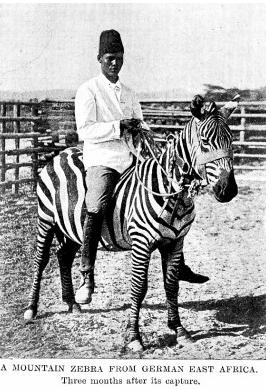|

A horse is a horse of course but some have stripes and are dangerous!
Whilst we are fascinated about this stripy horse relative, what do we really know about the zebra?
A horse is a horse of course but some have stripes and are dangerous
Zebras are high on our “must-see” lists of animals when we visit Africa. We are fascinated by these stripy horse relatives, and a zebra design has persisted for many years from “zebra crossings” to many fashion items (Dolce & Gabbana, Diane von Furstenberg, Oscar de la Renta, Christian LaCroix for example) to zebra rugs. Such questions as “Is a zebra a white animal with black stripes or a black animal with white stripes?” are debated, and many African folklore stories abound about how the zebra got its stripes.
Other questions are asked about why zebras have stripes to begin with – and believe it or not may scientists have spent time pondering this issue. Answer: it is a cooling system. When they stand in the sun, the black stripes heat the air and the white stripes cool the air, so there are continuous little breezes flowing over their backs. Answer: it is a system of camouflage. The outline of the zebra is broken up by the stripes, so the predators don’t see them, just as soldiers dressed in camouflage kits are hard to see. Answer: the stripes confuse the predator. When a lion rushes at a herd of zebras, all those stripes going this way and that prevent it from focusing on any single individual, so the herd gets away. Answer: it allows baby zebras to identify their mothers. Zebras might all look the same to us, like sheep in a field, but wait! – the foals that wandered off will find their mothers again through the equivalent of a system of fingerprints among the stripes. Answer: the stripes confuse tsetse flies. Answer: it just happened, and there is no need to look for an adaptive significance for every feature of an animal – why are elephants and rhinos grey and seagulls mostly white with some back and grey? But feel free to choose your favourite reason for zebra stripes.
Some also ask why the zebra was never domesticated. Homo sapiens evolved about 200,000 years ago, and did not leave Africa to take over the world until about 60,000 years ago. But, seemingly, though it took time, those colonists to new areas had some ideas about domestication. Dogs came on board first about 15,000 years ago, followed by goats, sheep, pigs, cattle and cats, and then horses about 6,000 years ago. Jared Diamond, in his book “Guns, germs, and steel” associates animal domestication with agriculture (crops), and also comes up with some theories about why the wildlife in Eurasia was more “domesticatable” than African species. I believe only some of his theories - Viv Wilson in Chipangali made reasonable proposals to domesticate duikers, Hannibal invaded Italy with African elephants, and cheetahs could have become reasonably tame after several millennia. I would not like to have been the first to begin an African buffalo domestication programme, but small children now ride around on Asian water buffalos.
But back to zebras. Eurasian horses, I would imagine, had the same nasty attitude as wild zebras long ago, but maybe in Africa there was not the equivalent of a horse whisperer to quieten them down and bear loads. Or maybe African populations had no need to domesticate any African wildlife in the past? They brought their own domestic animals with them after all? But while invaded by foreign species, the wildlife is fighting back with many versions of germ warfare…
Tsetse flies have been called the best friends of wildlife by keeping wide zones open for wildlife – cattle would die like flies if they entered the fly zones as the tsetse communicates trypanosomiasis. This is well known. Less well known is the way zebras not only fought against being domesticated, but also used their germ warfare (unknowingly of course) in terms of African horse sickness.
As the name implies, it affects horses to a great extent, donkeys and mules a bit less, and zebras hardly at all. It is an Orbivirus, communicated between hosts by a small flying insect called a midge, about the same size as a fruit fly. But horse sickness caused tremendous damage in Africa, changed transport systems, affected the outcome of the Boer War in terms of use of cavalry, led to the formation of the Onderstepoort Veterinary Institute in South Africa, and was compared to a Biblical scourge during the outbreak in the Cape in 1854/55.
Since the first State Veterinarian only arrived in South Africa in 1876 (and also did not know what to do about horse sickness), some highly fanciful cures were proposed. One farmer said he had had success by hanging an infected horse from a beam by its hind legs for a few minutes three times a day. Others proposed dosing the horses with methylated spirits, Cape brandy, whiskey, strong coffee, and giving subcutaneous injections of camphor dissolved in wine. The disease was thought to be caused by heavy dew, spiders and cobwebs in the grass, a poisonous atmosphere. Horses were advised to be stabled at night in smoky enclosures, kept away from low-lying areas and stagnant pools, rubbed all over with a mixture of garlic, aloe, and turpentine… but until a reasonably effective series of vaccines was discovered much later, horses and large parts of Africa did not mix.
Now, with climate change, the midge vector has extended its range northward to include Portugal, Italy, Spain, Greece, and has been found in southern Switzerland. African horse sickness itself has been recorded in Spain and Portugal… be prepared and stock up on some Cape brandy for your horses in the UK?
Picture credit and original publication: planyoursafari.com/blog/zebras-domestication-and-germ-warfare/
|




